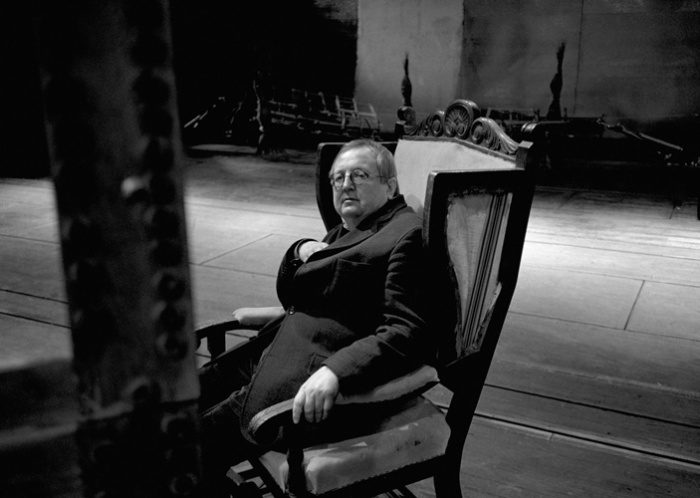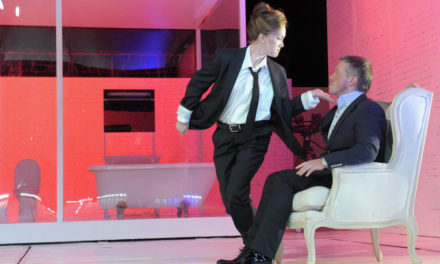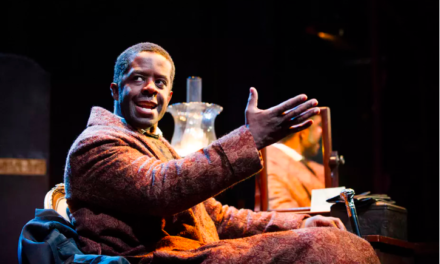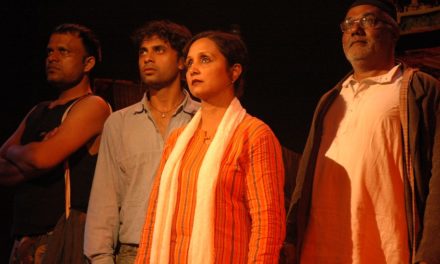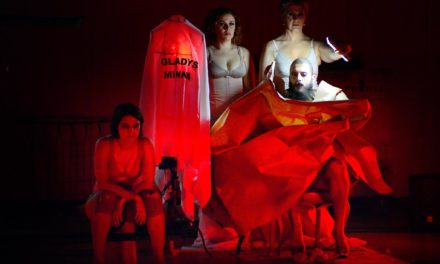Theatre works chiefly through temporal sequences and if Jerzy Grzegorzewski was in his artistic procedures similar to a stage manager, it was because he cared not about his mental images but about what happened in the audience.
He liked to say that he was just a stage manager. It sounded like coquetry but it meant more. The stage manager times the show by cueing performers and the changes on stage. Theatre works chiefly through temporal sequences and if Grzegorzewski was in his artistic procedures similar to a stage manager, it was because he cared not about his mental images but about what happened in the audience. That’s probably how it was, yet many viewers found it difficult. The problem, however, was probably not, as we once thought, a natural consequence of the artist’s peculiar imagination but rather part of a certain strategy.
Let’s take for example a figure as old-fashioned as the Sorcerer from Dziady. In the Warsaw staging, he solemnly announced the ritual and then, as Małgorzata Sugiera described it, he pulled out a pair of spectacles, cast a professorial glance at the Ghost of Gustaw, scattered grain in a theatrical gesture and then collected his things like an actor who had finished his role. Stopped by the others to explain the row of the kibitka wagons flying towards the north, with a face reddened with blood, he shouted in the tone of a Chaplinesque dictator, in a gesture both devious and theatrical: “Vengeance, vengeance, vengeance upon the enemy…”
In an earlier adaptation of Dziady, by Swinarski, the Sorcerer was also supposed to play something. It shows in the recording of a text rehearsal where Swinarski leads the actor towards professional theatricalization. He was supposed to be a visionary that was conscious of the audience as well as practical psychology. A recording of the actual performance, made 10 years later, shows how much this had become untrue. The irony has evaporated, the Sorcerer is but a noble old man here, a navigator of the ark of the covenant carrying the mythologically treated author, the viewers, and the whole theatre. The ambiguity is gone, the myth-craving audience has appropriated the Sorcerer against the director’s intentions.
Grzegorzewski didn’t let that happen again. He proceeded as if he had learned from the failures of Swinarski’s ironic approaches. He knew that the Romantic rhetoric would unfold when he gave it time. Verse-filled time, preferably. He prevented the show’s potential re-mythologization under the pressure of the audience’s symbolic imagination, blocking in advance the process of the neutralization of irony. Before building any images, he formed the text structure, building his own narrative, his own time. He followed the thinking of his authors but broke their time series, and, in the case of the Romantics, dismantled the common mythical time in the process. He replaced the musical cohesion of a poetic drama, which we felt familiar in, with time radically divided into fragments and devoid of traditional climaxes. Thus the chances also waned for the emergence of empathic collusion between the actor and the audience, a collusion that easily produces conventional effects.
Grzegorzewski, who staged his Dziady in Cracow in 1995, operated in a different world than Swinarski, for whom a new chapter had opened in terms of the ability to pragmatically draw on the resources of the Romantic rhetoric. No longer did the theatre have to harmonize so strongly with the audience’s expectations… And perhaps a completely different, new, relationship between the stage and the audience emerged. Perhaps the same fractures that Grzegorzewski observed, set a new theatre in motion in the 1990s, a theatre searching for drastic cracks in the whole that had been glued together again, a whole that has supposedly once existed. The collective world of the Cracow adaptation of Dziady by Joanna Walaszek was, in fact, a “trifle,” “chaos, void and noise,” or a grotesque salon–a cabaret. Mrs. Rollison was split into five women unbridled in their pained stylisation. In their martyrological insatiability, they became similar to the sheep-eyed ladies from the salon. The emotions tormenting the persecuted gradually became a quasi-erotic game with the Senator’s apparatchiks, and even today the working recording shows clearly that it was horrifying. But for the viewer, assaulted by the contradictions, it was also utterly incomprehensible.
Perhaps we were supposed to return to a truer state, to not understanding Dziady? Many viewers didn’t like that and Czesław Miłosz called the Cracow staging a “shame.” He believed that theatre’s role was to bring the archetype back, not to deny it. He didn’t award artistic autonomy to that art.
So is the purpose of the instrumentatrium to build an obstruction, and an aggressive one, at that? This seemed quite novel, yet there was also an experienced director’s thorough investigation of the contemporary custom in it, a perverse training of an operetta fan, as well as the Gombrowicz school. But, above all, Wyspiański. Introducing a new kind of reality, vague, a result of impatiently skipping the logical segments, of circling around a single motif, of explosively finding expression–altogether a “job as if only for oneself.” These are Karol Irzykowski’s impressions from the premiere of The Wedding.
The nonchalance, which, as we see, is already a hundred years old, caused stress, and even irritation, in some. But ordinary viewers, who were more indulgent towards the dangerous cascades of form-twisting and would not be intimidated, often reacted to that theatre in a much calmer manner. Their symbolic feelings were not hurt. Or perhaps they, we, were happy that even if in such a crippled form, Grzegorzewski still kindly allowed us to commune with the national myth? Sure, he raised formidable obstacles. With a little bit of goodwill, however, they could be considered temporary. Ultimately, they only lent credence–even if only for a moment–to a sense of completeness. The director himself seems to have tenderly communed with some of his images. Among those were the opening family scenes, where mythic children sang in their little sopranos the immaculate poetry of the Mickiewicz-Radwan pseudo-folk songs and were taught their prayers by mythical women…Moreover, those scenes were watched rather intensely by the main protagonist, played by Jerzy Radziwiłowicz. His close attention remained semi-hidden because the situations had been so arranged that he had to play with his back.
Still, there emerged an aura of enthusiasm, though meted out with unprecedented skimpiness and always suddenly interrupted–Grzegorzewski usually didn’t give it a chance to have a full effect. Bearing in memory the linear, poetic meter of the text, we had to push our way through the entanglements of the unexpected shapes and consequences. The fruit was forbidden, had to be secured by your own effort, in tension, with active counteraction from the demiurge.
In effect, it was a communion with mystery. You can say that it proceeded in a perverse aura of heresy. There were those who loved the taste of it. They accepted the tedious activity imposed on them, the lone search for connections, in which they shared the experience of loneliness with the protagonist. Throughout two acts the director lent him only small fragments of text, also making sure that he didn’t have his own place in the space of the stage. He was finally allowed to speak in the Great Improvisation, as if under the pressure of the layers of silence already piled up, infinitely lonely. That protagonist was a prototype, as Weronika Szczawińska guessed, of a very contemporary character of the last show, the pilgrim and spoiled man of fashion, drunk and clown, the grotesque decadent from The Second Return Of Odysseus. Both shows had scenes, episodes, fragments, similar to the pages of an intimate diary that can’t be presented in the form of a linear narrative because pages keep falling out of it.
The chorus part in Dziady was performed by a male choir standing behind concert stands. Conducted by Stanisław Radwan, it expressed itself in a musical manner, singing and chanting, cheering and vocalizing, to the accompaniment of kettledrums. Its expression was subjected to the impassive rigors of the concert. A silent–and then talking in the Great Improvisation–individual and a community enchanted in a formal-musical rigor: such was the dialogue here, such was the bond. On many occasions, Radwan’s music activated yet another image in Grzegorzewski’s theatre: the whirling of a miniature, foot-stomping crowd, drunk or unconscious for some other reason. That was the case in The Wedding, The Judges, The Second Return Of Odysseus. A spasmodic motif, obsessive, full of anxiety, it was a creative development of Malczewski’s “vicious circle” or Witkacy’s “mess”. Le Bohème, where the strange episode also found its way, was The Wedding in a modernist café, that is, in a landscape where the artist has lost his privileges and any importance he might have had.
Polish theatre, and art, and Conrad entered here, Grzegorzewski said, into a certain nonsense, an absurdity. Another variation was the Jama Michalikowa as the setting of Gombrowicz’s Operetta. Illusions have been hounded out of this world but there was a moment in La Bohème where everyone, arranged into an amateur chorus, with text printouts in their hands, sang the Prayer from The Liberation. It then appeared in Wyspiański’s Hamlet at the Narodowy, delivered magnificently by Ewa Konstancja Bułhak. In La Bohème, the Ghost (Olgierd Łukaszewicz) came for Marysia who sat in a café with the others, reached for her, took her from there, fawning at her feet. In the next scene, there’s a sapphire-blue streak on Marysia’s leg, a mark left by the inside of the Ghost’s hand. It is the color of The Wedding, the color of death, the color of the café’s wall décor. The forgotten color of laundry blue that peasants in southern Poland painted the whitewashed walls of their cottages with. At the end, Stanisław Radwan, by the piano, takes the first notes in an infinitely delicate manner and everyone starts singing pianissimo “You had, boor, a golden horn…” at which point Stanisław Szymański begins a bizarre, artificially slow dance against the sapphire-blue wall intersected by the spatial rhythm of the doors.
The rituals of that theatre were both provocative and discreet, large-scale and introvert at the same time… In the first place, we were supposed to forget ourselves in their vagueness. In this sense, theatre wanted to be an absolute practice here, but because such aspirations are associated with an outdated notion of the role of art, camouflaging maneuvers were needed. As a result of those and, above all, as a result of the whole reception-distorting instrumentarium, Grzegorzewski’s theatre has been remembered as arty and esoteric.
Jerzy Grzegorzewski
Born in 1939 in Łódź, a theatre director, and scenographer. A graduate of the Faculty of Directing, State Graduate School of Theatre in Warsaw. Debuted in 1966. He was a full-time director at the Stefan Jaracz Theatre in Łódź and then at the Stary Teatr in Cracow. 1978-1981, he was the art director of the Polish Theatre in Wrocław, then, for many years, the director of the S.I. Witkiewicz Studio Art Centre in Warsaw. In 1997, he was appointed the first director of the National Theatre, Warsaw, following its 12-year-long reconstruction.
Grzegorzewski’s Instrumentarium
Among Grzegorzewski’s most important stagings are Shakespeare’s Midsummer Night’s Dream, Różewicz’s Death in Old Decorations, Amerika after Franz Kafka, La Bohème after Stanisław Wyspiański’s The Wedding and Liberation, Wyspiański’s The Wedding and November Night, Witold Gombrowicz’s Operetta and The Wedding, New Bloomusalemafter James Joyce, and his last show, On. Drugi powrót Odyseusza [Him. The Second Return of Odysseus] after Wyspiański and Antonina Grzegorzewska. April 9, 2010 marked the fifth anniversary of his death.
Translated by Marcin Wawrzyńczak.
This post originally appeared on Biweekly.pl in May 2010 and has been reposted with permission.
This post was written by the author in their personal capacity.The opinions expressed in this article are the author’s own and do not reflect the view of The Theatre Times, their staff or collaborators.
This post was written by Malgorzata Dziewulska.
The views expressed here belong to the author and do not necessarily reflect our views and opinions.

